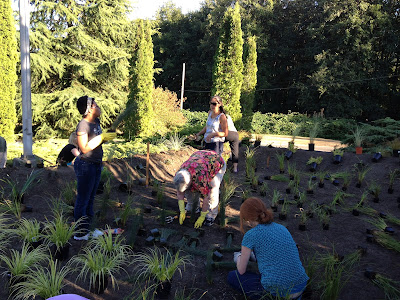PUD's rain garden has been getting a work out in past weeks. This is the October 31 storm. Notice the pipe that channels the excess water under the garden to the storm drain. The gravel is a pathway for water from even larger storms, which we experienced this month.
This is the beginning. Teresa Brooks and Brain Stahl from the Kitsap Conservation District are surveying the area for the raingarden. The rain garden will be 10% of the impervious surface area that drains to it.
This spot was chosen because water from the parking lot naturally flows toward this area as you can see by the weather worn curb.
Let the digging begin. This is our own Jason Thorne is running the excavator. The old bushes were removed and hauled away. A berm was created to form a depression 18" deep.
A mixture of compost and sand was added. The bottom had to be perfectly leveled.
An overflow pipe was connected to the existing storm drain.
A new curb was in order, creating an inlet for the sheeting rain from the parking lot.
Look at that perfectly sculptured rain garden ready for planting.
After the rain garden was planted, Our guys created an asphalt "speed bump" across the driveway to guide rain water into the garden.
Our rain garden slows down the storm water that runs off the parking lot. It absorbs and cleans water that would have rushed down the storm drain and into the Puget Sound.







.jpg)

























